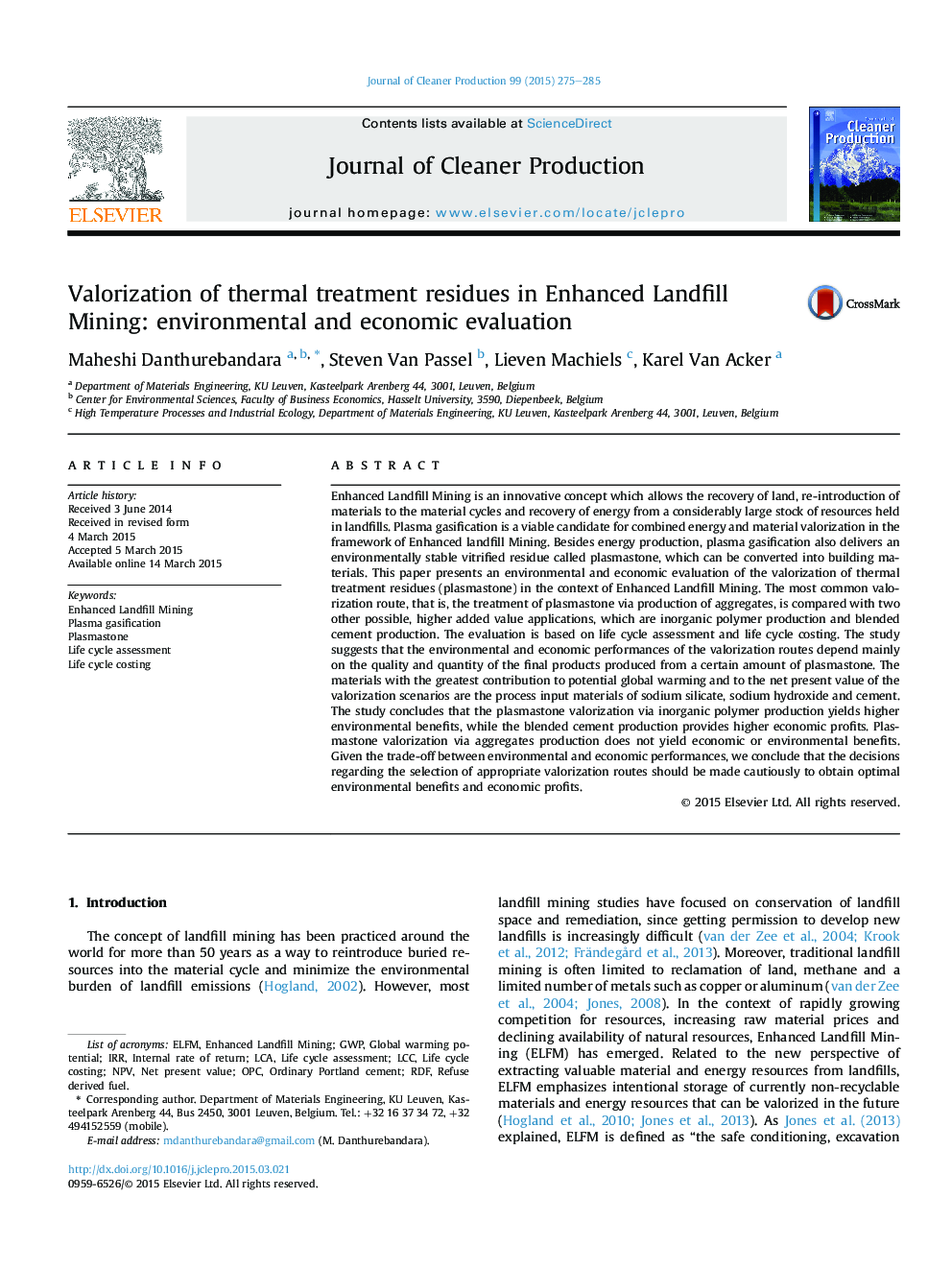| کد مقاله | کد نشریه | سال انتشار | مقاله انگلیسی | نسخه تمام متن |
|---|---|---|---|---|
| 8104127 | 1522147 | 2015 | 11 صفحه PDF | دانلود رایگان |
عنوان انگلیسی مقاله ISI
Valorization of thermal treatment residues in Enhanced Landfill Mining: environmental and economic evaluation
ترجمه فارسی عنوان
ارزیابی مانده های درمان حرارتی در معادن زباله پیشرفته: ارزیابی محیطی و اقتصادی
دانلود مقاله + سفارش ترجمه
دانلود مقاله ISI انگلیسی
رایگان برای ایرانیان
کلمات کلیدی
RDFGWPOPCIRRLCCnet present value - ارزش خالص فعلیLCA - ارزیابی چرخه حیاتLife Cycle Assessment - ارزیابی چرخه عمر یا چرخه حیاتrefuse derived fuel - سوخت مشتق شده را رد کنیدOrdinary Portland Cement - سیمان پرتلند معمولیEnhanced landfill mining - معدن زباله های زباله پیشرفتهNPV یا negative predictive value - مقادیر پیش بینی شده منفیInternal rate of return - نرخ بازده داخلیLife cycle costing - هزینه چرخه زندگیglobal warming potential - پتانسیل گرمایش جهانیPlasma Gasification - گازسیون پلاسما
ترجمه چکیده
معادن زباله پیشرفته یک مفهوم نوآورانه است که اجازه می دهد تا زمین بازیابی، دوباره معرفی مواد به چرخه مواد و بازیابی انرژی از منابع قابل توجهی از منابع موجود در دفن زباله. گازسوز سازی پلاسما یک نامزد قابل قبول برای ترکیب مواد و انرژی در چارچوب معادن زباله پیشرفته است. علاوه بر تولید انرژی، گازسوز شدن پلاسما نیز یک بقایای مجذور زیست سازگار باقی مانده را به نام پلاسماستون ارائه می دهد که می تواند به مواد ساختمانی تبدیل شود. این مقاله ارزیابی زیست محیطی و اقتصادی ارزشیابی بقایای درمان حرارتی (پلاسماستون) را در زمینه معادن زباله پیشرفته ارائه می دهد. شایع ترین روش ارزش گذاری، یعنی درمان پلاسماستون از طریق تولید سنگ آهک، با دو برنامه کاربردی با ارزش افزوده بیشتر، که تولید پلیمر غیر معدنی و تولید مخلوط سیمان است، مقایسه می شود. ارزیابی بر مبنای ارزیابی چرخه زندگی و هزینه های چرخه زندگی است. مطالعه نشان می دهد که عملکرد محیطی و اقتصادی مسیرهای ارزشمند به طور عمده به کیفیت و کمیت محصولات نهایی تولید شده از مقدار معینی از پلاسماستون بستگی دارد. مواد با بیشترین کمک به بالقوه گرم شدن کره زمین و ارزش فعلی خالص سناریوهای ارزش گذاری عبارتند از مواد ورودی فرآیند سدیم سیلیکات، هیدروکسید سدیم و سیمان. این مطالعه نتیجه می گیرد که ارزش گذاری پلاسماستون از طریق تولید پلیمرهای غیر معدنی باعث افزایش مزایای زیست محیطی می شود، در حالیکه تولید سیمان مخلوط، سود اقتصادی بیشتری را به وجود می آورد. ارزش گذاری پلاسماستون از طریق تولید آلیاژها مزایای اقتصادی یا محیط زیستی ندارد. با در نظر گرفتن مناقشات بین عملکرد اقتصادی و زیست محیطی، نتیجه گیری می کنیم که تصمیم گیری در مورد انتخاب مسیرهای ارزشمند مناسب باید به صورت محتاطانه صورت گیرد تا منافع محیطی و سود اقتصادی به دست آید.
موضوعات مرتبط
مهندسی و علوم پایه
مهندسی انرژی
انرژی های تجدید پذیر، توسعه پایدار و محیط زیست
چکیده انگلیسی
Enhanced Landfill Mining is an innovative concept which allows the recovery of land, re-introduction of materials to the material cycles and recovery of energy from a considerably large stock of resources held in landfills. Plasma gasification is a viable candidate for combined energy and material valorization in the framework of Enhanced landfill Mining. Besides energy production, plasma gasification also delivers an environmentally stable vitrified residue called plasmastone, which can be converted into building materials. This paper presents an environmental and economic evaluation of the valorization of thermal treatment residues (plasmastone) in the context of Enhanced Landfill Mining. The most common valorization route, that is, the treatment of plasmastone via production of aggregates, is compared with two other possible, higher added value applications, which are inorganic polymer production and blended cement production. The evaluation is based on life cycle assessment and life cycle costing. The study suggests that the environmental and economic performances of the valorization routes depend mainly on the quality and quantity of the final products produced from a certain amount of plasmastone. The materials with the greatest contribution to potential global warming and to the net present value of the valorization scenarios are the process input materials of sodium silicate, sodium hydroxide and cement. The study concludes that the plasmastone valorization via inorganic polymer production yields higher environmental benefits, while the blended cement production provides higher economic profits. Plasmastone valorization via aggregates production does not yield economic or environmental benefits. Given the trade-off between environmental and economic performances, we conclude that the decisions regarding the selection of appropriate valorization routes should be made cautiously to obtain optimal environmental benefits and economic profits.
ناشر
Database: Elsevier - ScienceDirect (ساینس دایرکت)
Journal: Journal of Cleaner Production - Volume 99, 15 July 2015, Pages 275-285
Journal: Journal of Cleaner Production - Volume 99, 15 July 2015, Pages 275-285
نویسندگان
Maheshi Danthurebandara, Steven Van Passel, Lieven Machiels, Karel Van Acker,
